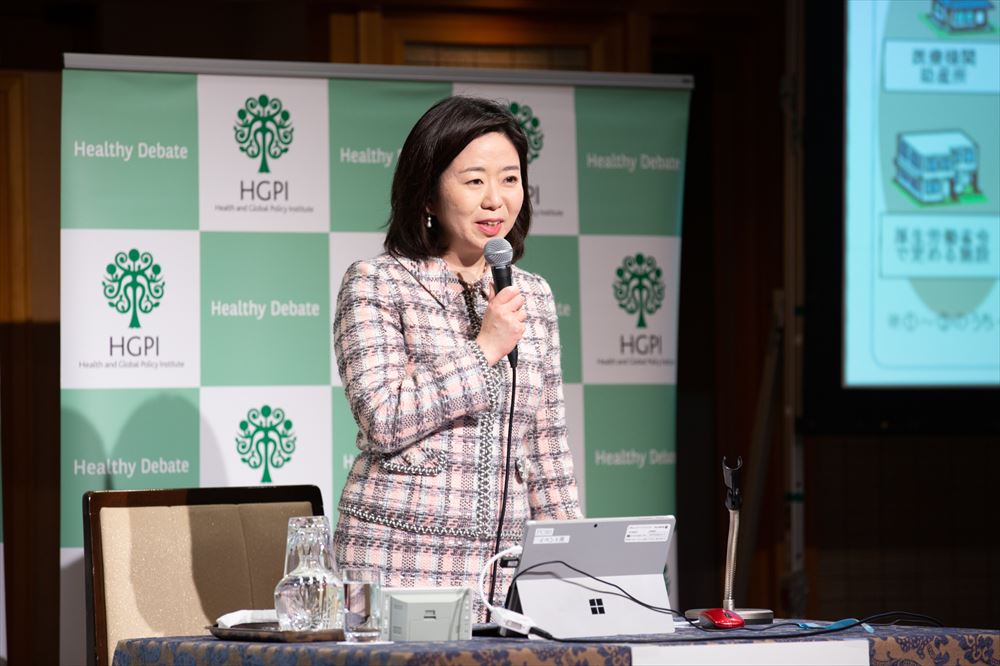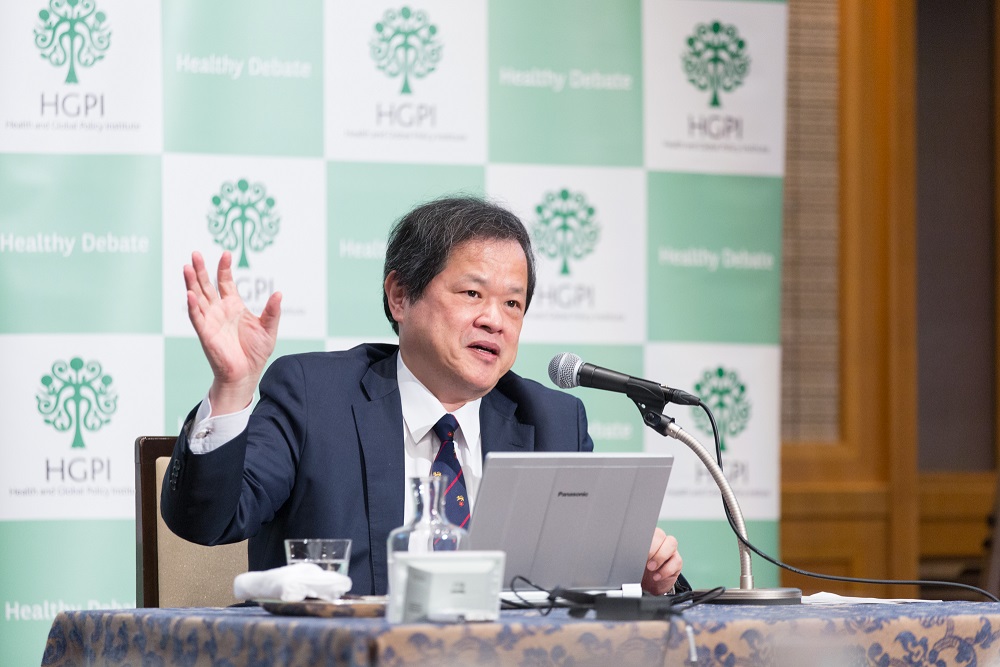[Event Report] The 47th Special Breakfast Meeting – Shaping Japan’s Healthcare and Social Security for the Future – Issues and Prospects (February 25, 2022)
date : 5/12/2022
Tags: Future of the Health Care System, Special Breakfast Meeting
![[Event Report] The 47th Special Breakfast Meeting – Shaping Japan’s Healthcare and Social Security for the Future – Issues and Prospects (February 25, 2022)](https://hgpi.org/en/wp-content/uploads/sites/2/sbm-47-1-top.jpg)
For the 47th Special Breakfast Meeting, we hosted Mr. Gaku Hashimoto (Member of the House of Representatives, Chair of the Committee on Health and Welfare, and Former State Minister of Health, Labour and Welfare (MHLW)).
To prevent the spread of COVID-19 infections no meals were served, the venue was thoroughly disinfected, the flow of people at the venue was controlled, and guest capacity was limited.
Key points of the lecture
- Initiatives for responding to changes in the structure of Japanese society surrounding social security caused by population aging and a declining birthrate
- Three pillars for balancing the healthcare provision system and improving efficiency through digitalization
■ The meaning of social security
Social security was established with an aim to function on the basis of everyone supporting one another so that the country and society can live in peace and security. One objective shared by Diet members is keeping Japan safe. National security must always be considered as unforgivable actions such as the war between Russia and Ukraine have occurred. However, it is not enough to only be ready for external threats. Problems like poverty, disease, and aging are enemies of human society that we will always face. For society to be safe and secure, we must be prepared for such challenges. These preparations include establishing insurance systems like the health insurance system, the pension system, and the unemployment insurance system. These systems were established so people can support each other. For example, if someone loses their ability to work due to a disability or similar reason, Article 25 of the Constitution of Japan guarantees the “right to maintain the minimum standards of wholesome and cultured living.” The term “security” is applicable in the sense that Japan protects people’s safety through these systems. It is the presence of both “national security” and “social security” that enables us to live in safety and with peace of mind.
 ■ The outlook for Japanese society and issues facing social security
■ The outlook for Japanese society and issues facing social security
Right now, Japan’s population is on the decline, and the number of elderly people age 65 and over has been rising. In the future, a shrinking working-age population will also contribute to population decline. Some people have been saying society will enter an era of population aging for almost four decades, and we have been preparing systems so we can be ready. That is exactly what is happening now. By popularizing long-term care insurance services and similar services, we were able to meet the needs of the current era. However, in the future, the size of the working-age population will become even smaller as the childbearing generation shrinks.
From a public finance perspective, social security expenditures are continuing on an upward trend. Projections show spending on social security benefits will continue to grow due to support provided to programs like pensions, healthcare, long-term care, and childcare. However, we should be able to finance these programs if we aim for sufficient economic growth. Pension spending as a proportion of GDP is also trending upwards, but if pension spending is adjusted according to economic growth by incorporating a mechanism called the “macroeconomic slide,” pensions are unlikely to strain public finances.
Healthcare and long-term care are two fields that lack such a mechanism. This would also not be an issue if the economy continued to grow alongside spending, but rapid economic growth is difficult to achieve. This means the current generation will continue shouldering the burden of increasing expenditures, which will put pressure on their daily lives. This remains a major issue.
One strength of Japan’s healthcare system is that compared to other G7 countries, both average and healthy life expectancies are increasing. We must think about how to overcome the challenge of retaining the strengths of that system while addressing cost-associated burdens.
Meanwhile, comparing elderly people in the past with elderly people today, we see that elderly people today are younger in terms of physical fitness levels. These levels are equivalent to about one generation younger than for elderly people twenty years ago. Women, in particular, have become about ten years younger. As such, instead of seeing themselves as “elderly” at age 65, people now feel they are “elderly” at age 75 or 80.
In light of these circumstances, we can see that social security will place an increasing burden on public finances in the future. In addition, due to a shrinking workforce, there are fewer people to support fields like healthcare and long-term care. Securing human resources for these roles is also becoming an issue. To address these issues, the number of people who are young at age 65 will continue increasing in the future, so we may have to ask them to provide their labor. We must also consider methods of handling workloads more efficiently with fewer people, such as by improving efficiency in workplaces (not in terms of public finance) and applying technology and other tools.
■ Issues for relief needed after disasters
As Japan’s population ages, we see that many of the people who gather at evacuation centers after disasters occur are elderly. At times like that, rather than emergency rescue services and care for injured people, what is needed is care for chronic conditions or welfare and long-term care. Compared to the responses to past disasters like the Great Hanshin Earthquake, the quality of post-disaster support has changed, and we must recognize and respond to those changes.
■ Key healthcare system reforms
There are three guidelines being considered with the objective of comprehensive healthcare provision system reform.
- Achieve the optimal arrangement of healthcare institutions and collaboration
Looking at how needs regarding healthcare quality and quantity change as the population ages and declines, we can also see an ongoing shift in issues that require consideration when determining how to best structure community healthcare. Currently, Japan has more private hospitals than public or municipal hospitals and they are not part of a system that the government controls. It is undesirable for inefficient healthcare systems to remain in place despite shifting healthcare needs, so we think reform is necessary. After we gather Hospital Bed Classification Reports, ascertain the function of those hospitals and their beds, and create projections for circumstances surrounding healthcare in 2025, we will consider healthcare systems that meet future needs. These items are examined at Regional Medical Care Vision Planning and Coordination Councils, which are considering how to establish balanced healthcare systems in each region. There have been times figures provided by Hospital Bed Classification Reports have been of use when identifying which issues require attention. For example, the FY2020 Hospital Bed Classification Report showed there will be a mismatch between the actual number of hospital beds and projections for FY2025.
- Reform work styles for physicians and medical professionals
Accompanying work style reform, working hour regulations have been put in place and efforts have been made to keep overtime hours within the upper limit. However, not all workers are subject to these restrictions, and there are some physicians whose circumstances are exceptional. This means some people tend to work more overtime. We have also observed that in certain regions, physicians serving at private hospitals become so overburdened with work that they sometimes cannot continue working as physicians.
I hope physicians can obtain sustainable working conditions by introducing regulations on upper working hour limits in 2024.
A revision to the law that designated legal status for student doctors made it possible for them to engage in medical practice even during training, and there is also a training initiative to help physicians build experience in clinical settings and begin practicing as soon as possible.
- Take effective measures to address uneven distributions of physicians
Physicians are free to select their field of practice and the government cannot designate where they work. However, there are efforts to prevent uneven distributions of physicians such as by setting regional quotas and by placing employment limits on the number of specialists in certain fields.
On the topic of finances in the health insurance system, in anticipation of rising future healthcare expenses, medical copayments for late-stage elderly people who meet certain income requirements will be increased to 30% from the current rate of 10%. Methods of avoiding a sudden increase in the burden were discussed, and included stepping the rate up to 20% first. The discussion is now heading in a direction in which the burden will be increased gradually for those who can shoulder it.
Every two years, the medical service fee schedule is revised and the drug pricing system is reviewed. However, some are apprehensive about lowering pharmaceutical prices to cover other healthcare expenses due to the risk of pharmaceutical manufacturers disappearing from Japan, and there are concerns about the sustainability of the current status quo. Given the current need for COVID-19 countermeasures, Japanese pharmaceutical manufacturers are also moving rapidly to develop vaccines, but these efforts are lagging behind the rest of the world. In the future, we want to catch up.
Regarding infectious disease control, we must not only consider measures for the current situation, but also measures for preventing the emergence of a new infectious disease epidemic in the next ten years or so. Based on lessons learned from COVID-19, we should also consider measures for digitalization and genomic medicine.
A question-and-answer session with the audience followed the lecture, and a lively exchange of ideas took place.
(Photographed by: Kazunori Izawa)
■ Profile
Mr. Gaku Hashimoto (Member of the House of Representatives, Chair of the Committee on Health and Welfare, and Former State Minister of Health, Labour and Welfare (MHLW))
Elected five times as a member of the House of Representatives, Mr. Gaku Hashimoto currently serves the 4th Electoral District of Okayama Prefecture (Hayashima and Kurashiki). He is currently the Chairperson of the House of Representatives Committee on Health, Labour and Welfare; Chief Secretary of the LDP Headquarters for Creating Bright Future Society for Children and Young People; and Chief Secretary of the LDP Research Commission on Social Security System. He formerly served as the Director of the House of Representatives Budget Committee; Managing Director of the House of Representatives Committee on Health, Labour and Welfare; Member of the LDP General Council; Chairperson of the Federation of Okayama Prefecture LDP Branches; the State Minister of Health, Labour and Welfare; Director of the LDP Policy Research Council’s Health, Labour and Welfare Division; Director of the LDP Policy Research Council’s Foreign Affairs Division; and as Parliamentary Secretary for Health, Labour and Welfare. Born February 5, 1974, Mr. Hashimoto is a native of Soja City, Okayama Prefecture. He graduated from Keio University’s Faculty of Environment and Information Studies in 1996 and Graduate School of Media and Governance in 1998.
Top Research & Recommendations Posts
- [Policy Recommendations] Achieving a Sustainable Society of Health and Longevity Through the Integration of Environment and Healthcare-Incorporating a Planetary Health Perspective into the 3rd Phase of The Healthcare Policy-(December 20, 2024)
- [Research Report] Building a Mental Health Program for Children and Measuring its Effectiveness (June 16, 2022)
- [Policy Recommendations] Integrating Climate and Health for a Sustainable Society: Incorporating a Planetary Health Perspective into Nationally Determined Contributions (NDCs)(December 9, 2024)
- [Policy Recommendations] Policy Recommendations on Strengthening CKD Strategies for Workers: The Importance of Providing Early Detection, Intervention, and Support Through Screenings and Medical Visits (October 28, 2024)
- [Research Report] The 2023 Public Opinion Survey on Satisfaction in Healthcare in Japan and Healthcare Applications of Generative AI (January 11, 2024)
- [Policy Recommendations] Developing a National Health and Climate Strategy for Japan (June 26, 2024)
- [Event Report] Planetary Health Expert Meeting Aiming for Sustainable Healthcare: Learning from the Impact of Environmental Pollution and Medical Waste During the Pandemic (February 16, 2024)
- [Policy Recommendations] Obesity Control Promotion Project 2023 “The Next Steps for Engaging and Cooperating with Patients, Citizens, and Communities for Implements of Obesity Control Measurements” (April 8, 2024)
- [Announcement] A Turning Point Towards Building Green Healthcare Systems (June 5, 2024)
- [Research Report] Survey of Japanese Physicians Regarding Climate Change and Health (December 3, 2023)
Featured Posts
-
2024-11-25
[Registration Open] (Webinar) The 130th HGPI Seminar “Marking a Decade of the Act on Medical Care for Patients With Intractable Diseases: Connecting Intractable Diseases and Society From the Perspective of a Media Professional and Family Member” (January 28, 2025)
![[Registration Open] (Webinar) The 130th HGPI Seminar “Marking a Decade of the Act on Medical Care for Patients With Intractable Diseases: Connecting Intractable Diseases and Society From the Perspective of a Media Professional and Family Member” (January 28, 2025)](https://hgpi.org/en/wp-content/uploads/sites/2/hs130-top_JPNENG-1.png)
-
2024-12-18
[Policy Recommendations] Policy Recommendations on Strengthening CKD Strategies for Workers: The Importance of Providing Early Detection, Intervention, and Support Through Screenings and Medical Visits (October 28, 2024)
![[Policy Recommendations] Policy Recommendations on Strengthening CKD Strategies for Workers: The Importance of Providing Early Detection, Intervention, and Support Through Screenings and Medical Visits (October 28, 2024)](https://hgpi.org/en/wp-content/uploads/sites/2/HGPI_20241023_FY2024CKD_eyecatch.jpg)
-
2024-12-20
[Policy Recommendations] Achieving a Sustainable Society of Health and Longevity Through the Integration of Environment and Healthcare-Incorporating a Planetary Health Perspective into the 3rd Phase of The Healthcare Policy-(December 20, 2024)
![[Policy Recommendations] Achieving a Sustainable Society of Health and Longevity Through the Integration of Environment and Healthcare-Incorporating a Planetary Health Perspective into the 3rd Phase of The Healthcare Policy-(December 20, 2024)](https://hgpi.org/en/wp-content/uploads/sites/2/e8a714648913193b03d5b6ede38c161e.png)
-
2024-12-25
[Registration Open] (Hybrid Format) Expert Meeting “Innovations Required to Achieve Precision Psychiatry” (January 22, 2025)
![[Registration Open] (Hybrid Format) Expert Meeting “Innovations Required to Achieve Precision Psychiatry” (January 22, 2025)](https://hgpi.org/en/wp-content/uploads/sites/2/mh-20250122-topr-1.png)
-
2024-12-27
[Activity Report] Second UN General Assembly High-Level Meeting on AMR (September 26, 2024)
![[Activity Report] Second UN General Assembly High-Level Meeting on AMR (September 26, 2024)](https://hgpi.org/en/wp-content/uploads/sites/2/4ED86AF7-49DE-465D-B59D-843B4F3C6102_1_201_a-scaled-1.jpeg)








